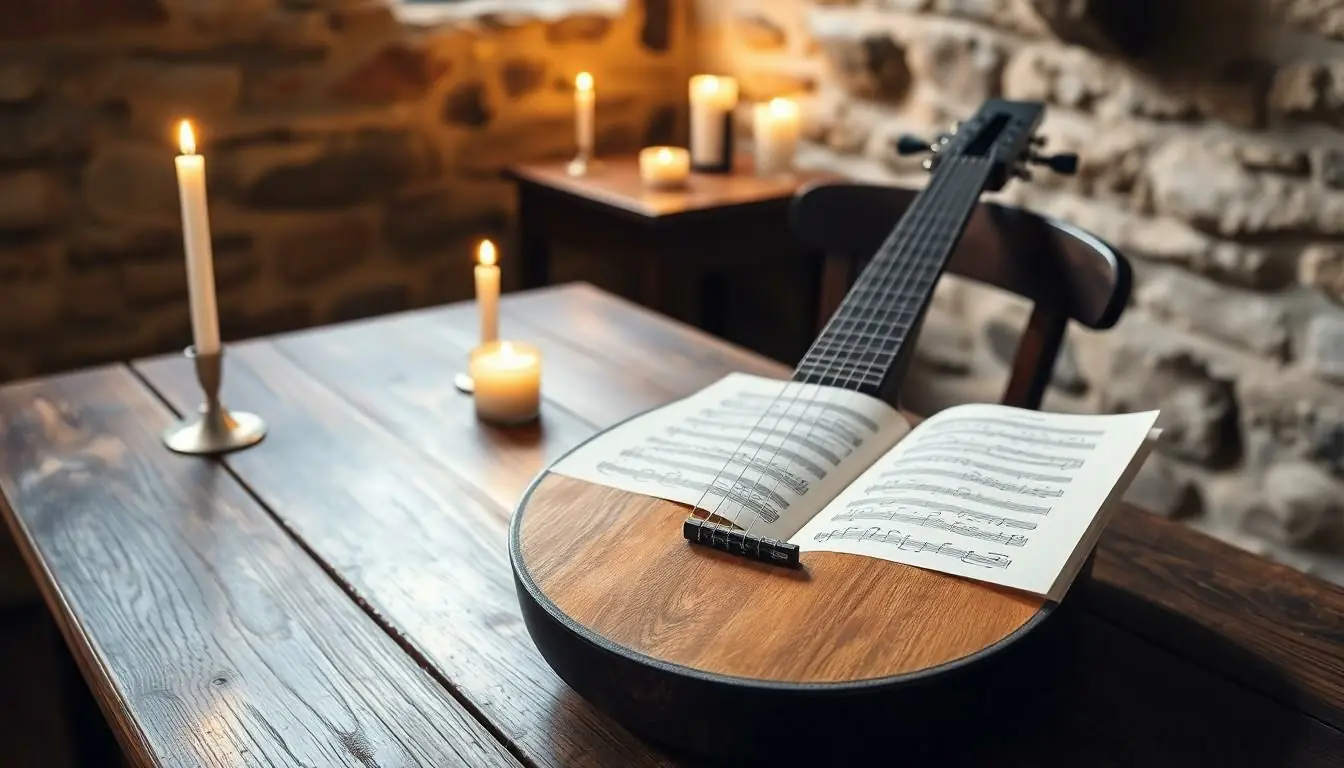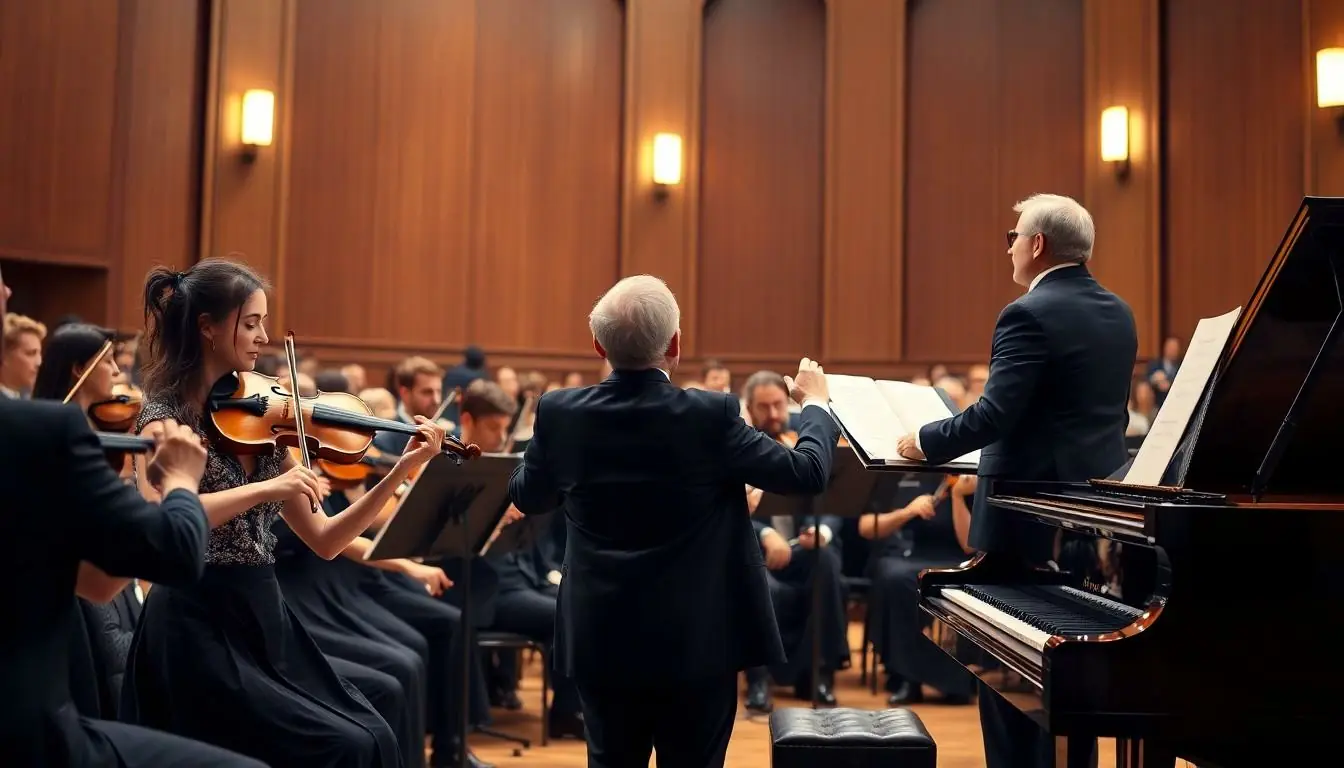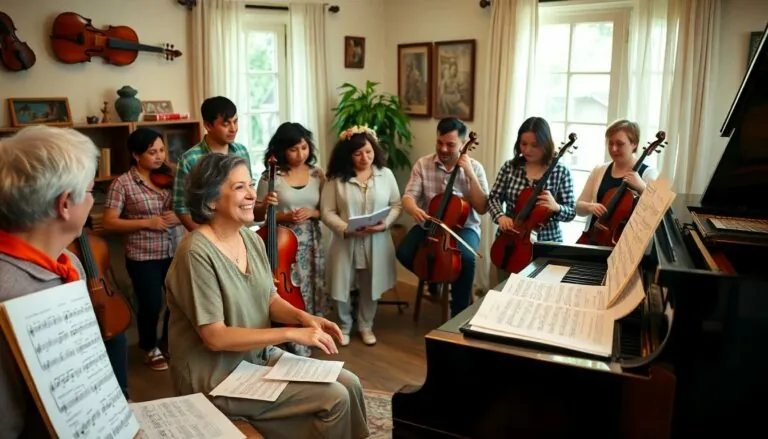Table of Contents
ToggleClassical music might seem like a stuffy affair reserved for tuxedo-clad conductors and snooty concertgoers, but it’s actually a vibrant tapestry of creativity and innovation. From the baroque brilliance of Bach to the romantic fervor of Chopin, this timeline reveals how centuries of composers shaped the soundscape we know today.
Overview of Classical Music
Classical music encompasses a wide range of styles and periods, reflecting its rich history. Spanning from the medieval era to contemporary compositions, this genre showcases diverse techniques and emotional depth. The timeline of classical music can be divided into several key periods: Medieval, Renaissance, Baroque, Classical, Romantic, and Modern.
Medieval music, originating around 500 AD, emphasized vocal forms like Gregorian chant. In contrast, the Renaissance period, from 1400 to 1600, introduced polyphony and new instrumental developments. Significant composers such as Josquin des Prez and Palestrina emerged, focusing on harmony and texture.
The Baroque period, extending from 1600 to 1750, witnessed the rise of dramatic expression and ornamentation. Composers like Johann Sebastian Bach and George Frideric Handel expanded the use of contrast, exploring suites, concertos, and oratorios. Classical music then transitioned into the Classical period, which roughly spanned 1750 to 1820. Composers such as Wolfgang Amadeus Mozart and Joseph Haydn emphasized clarity, balance, and form.
Following this, the Romantic era (1820 to 1900) focused on individual expression and emotional intensity. Composers like Frédéric Chopin and Johannes Brahms pushed the boundaries, integrating nationalistic elements and programmatic music.
Modern classical music, beginning in the 20th century and continuing today, showcases innovations in style, structure, and technology. Composers such as Igor Stravinsky, Arnold Schoenberg, and John Cage challenged traditional norms and explored new soundscapes.
Throughout its evolution, classical music remains a vital, influential form of artistic expression that continually shapes contemporary music. The contributions of these composers highlight the genre’s ongoing relevance and dynamism.
Early Classical Music

Early classical music spans significant periods, including the Medieval and Renaissance eras. Each phase brought unique developments and styles that laid the groundwork for future compositions.
The Medieval Period
Medieval music emerged around the 500 AD mark, characterized by Gregorian chant, which focused on monophonic melodies. Composers like Hildegard von Bingen contributed influential works during this era, emphasizing spirituality and liturgical themes. Notably, musicians developed notation systems around the 9th century, enabling more complex compositions. This period also witnessed the rise of polyphony in the late medieval years, where multiple independent melodies coexisted. Instruments such as the lute and vielle became prevalent, enriching the musical landscape.
The Renaissance Period
Renaissance music flourished from about 1400 to 1600, marked by greater emphasis on harmony and expressive vocal techniques. Pioneers like Josquin des Prez and Palestrina made significant contributions, merging sacred and secular themes. Composers began exploring counterpoint, leading to intricate musical textures. The invention of the printing press around 1450 facilitated the distribution of music, enhancing accessibility. Additionally, the shift toward greater individual expression in compositions became evident, setting the stage for the subsequent Baroque period.
The Baroque Era
The Baroque Era, spanning approximately 1600 to 1750, marked a significant shift in musical expression. This period emphasized emotional depth and dramatic contrast, transforming the landscape of classical music.
Key Composers and Works
Johann Sebastian Bach remains a pivotal figure of the Baroque period. His masterpieces, such as the Brandenburg Concertos and The Well-Tempered Clavier, showcase intricate counterpoint and structural innovation. George Frideric Handel contributed significantly with oratorios like Messiah, which blend lush melodies and religious themes. Antonio Vivaldi, known for The Four Seasons, brought vibrant energy and virtuosic string writing to the forefront. Other notable composers include Heinrich Schütz and George Philipp Telemann, each enriching the musical tapestry of the time.
Musical Innovations
The Baroque Era introduced pivotal innovations in music. Composers developed the concept of the concerto, highlighting the contrast between solo instruments and orchestral accompaniment. This era also saw the rise of opera, where storytelling merged with music, and figures like Claudio Monteverdi paved the way for dramatic expression. Ornamentation flourished, allowing performers to showcase their virtuosity through embellishments. Furthermore, the establishment of tonality provided a foundation for Western music, influencing compositions in subsequent periods.
The Classical Period
The Classical Period, spanning from 1750 to 1820, marked a pivotal era in music. Composers during this time emphasized clarity, balance, and form.
Major Composers
Wolfgang Amadeus Mozart emerged as a leading figure, creating symphonies, operas, and chamber works. His pieces, such as The Magic Flute and Eine kleine Nachtmusik, showcase his melodic genius. Franz Joseph Haydn, often called the “Father of the Symphony,” made substantial contributions with his 104 symphonies and string quartets, reinforcing structural conventions. Ludwig van Beethoven’s unique blend of Classical and Romantic styles left an indelible mark with masterpieces like Symphony No. 5 and Moonlight Sonata. Each of these composers played a crucial role in shaping the Classical music landscape, influencing subsequent generations.
Characteristics of the Music
Classical music from this period exhibits structured forms like sonata-allegro and rondo. Clarity defines the texture, often utilizing homophony, where a single melody dominates supported by harmonious chords. The orchestration notably expanded, with the inclusion of woodwinds and brass enhancing the sound palette. Emotional expression increased, moving beyond the Baroque’s ornamentation to more direct communication. Dynamics experienced greater contrast, leading to dramatic shifts in volume. These attributes collectively contributed to the era’s enduring legacy in Western music history.
The Romantic Era
The Romantic Era, spanning from approximately 1820 to 1900, marked a profound shift in musical expression. This period emphasized individuality and emotional depth, inviting composers to explore the inner workings of human experience.
Emotional Expression in Music
Composers embraced intense feelings, transforming music into a powerful medium for expressing passion and sentiment. Franz Liszt and Richard Wagner, for instance, utilized rich harmonies and innovative structures to evoke strong emotions. Chopin’s piano works, such as his Nocturnes and Etudes, convey personal reflections and romantic longing. Themes of love, nature, and the supernatural frequently emerged, resonating with listeners on a visceral level. This commitment to heartfelt expression revolutionized musical composition, encouraging musicians to prioritize emotional connectivity over traditional forms.
Significant Influence on Modern Music
Modern music owes a significant debt to the Romantic Era, shaping its foundational elements and stylistic choices. Genres such as film scores and popular music frequently draw on sweeping melodies and rich orchestration pioneered by Romantic composers. Composers like Tchaikovsky and Mahler introduced expansive emotional landscapes that have inspired contemporary artists. The exploration of complex harmonies and unconventional structures continues to manifest in diverse musical genres today. Elements such as the use of leitmotifs and dramatic contrasts can be traced back to the innovations of this era, highlighting its enduring impact on the evolution of music.
The 20th Century and Beyond
The 20th century transformed classical music through diverse movements and groundbreaking innovations. This era witnessed the rise of new styles, including Impressionism, minimalism, and experimental music, reflecting broader cultural shifts.
Evolution of Classical Music
Composers like Claude Debussy and Igor Stravinsky challenged traditional norms, introducing fresh perspectives. Debussy’s use of non-traditional scales in pieces such as Clair de Lune created a distinct sound. Stravinsky’s The Rite of Spring famously altered rhythmic structures, causing a riot at its premiere in 1913. Electronic music emerged in the mid-20th century, influencing composers like Karlheinz Stockhausen and John Cage. Stockhausen’s work pushed the boundaries of sound, while Cage’s exploration of chance helped redefine musical composition. Opportunities for collaboration across genres expanded classical music’s reach and accessibility.
Contemporary Classical Composers
Contemporary composers continue to shape the classical landscape, incorporating various influences. Figures like Philip Glass and Arvo Pärt exemplify this diversity through unique styles. Glass’s minimalist compositions often blend with elements of rock and pop, attracting wider audiences. Pärt’s spiritually infused works, characterized by tintinnabulation, resonate deeply with listeners. Additionally, young composers push the envelope, exploring multimedia and interactive experiences. The fusion of technology and traditional elements enhances performances, making classical music more engaging than ever. As these artists redefine the genre, classical music remains a vital part of today’s cultural fabric.
Classical music’s journey through time showcases its vibrant evolution and adaptability. From the spiritual tones of the Medieval period to the emotional depths of the Romantic era and the innovative spirit of the 20th century, each phase has contributed to a rich tapestry of sound. This genre continues to inspire modern composers and musicians, proving that classical music is far from elitist. Instead, it remains a dynamic art form that resonates with audiences today. As it blends tradition with contemporary influences, classical music’s legacy endures, inviting new generations to explore its beauty and complexity.






